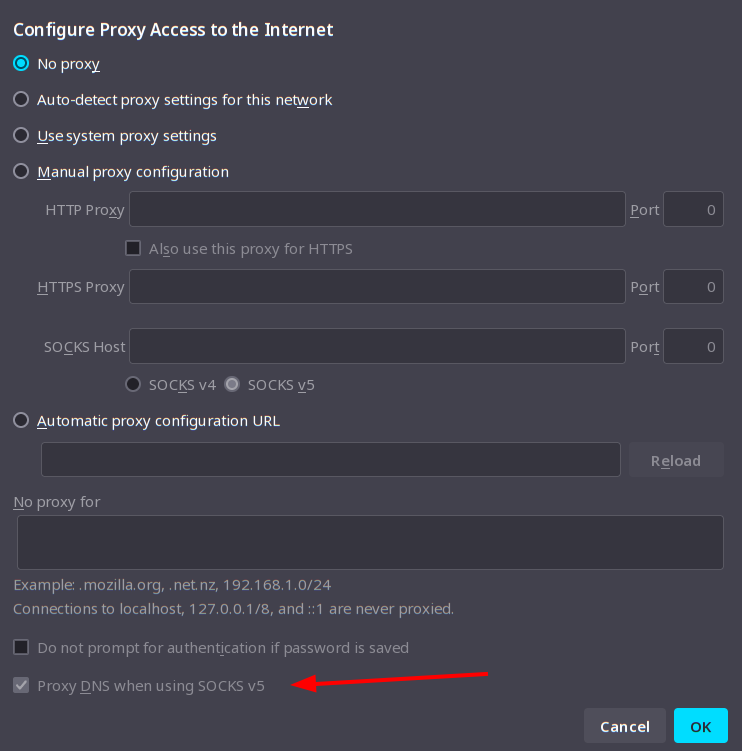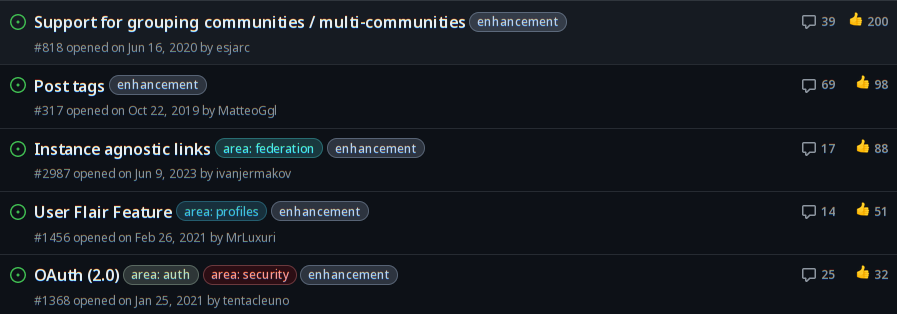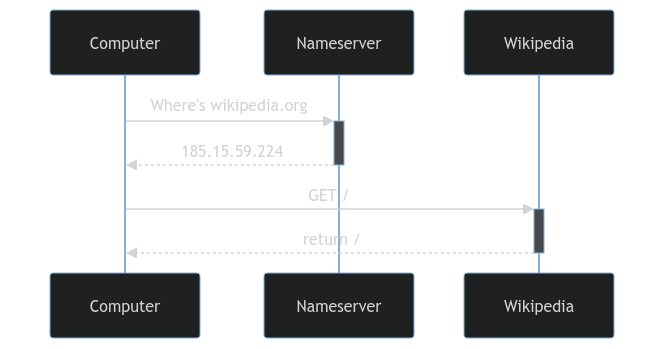- 57 Posts
- 2.3K Comments

 4014·5 hours ago
4014·5 hours agoSo trying to hack hackthebox is not permitted? Confusion is the name of the game

 23·5 hours ago
23·5 hours agosequenceDiagram Computer->>+Nameserver: Where's wikipedia.org Nameserver-->>-Computer: 185.15.59.224 Computer->>+Wikipedia: GET / Wikipedia-->>-Computer: return /Here is the simplified sequence diagram
As you can see the request to wikipedia itself does not go through a nameserver, only the DNS request does. It’s the entire reason Firefox has the option to proxy DNS queries over the proxy: to avoid DNS leaks

Right now, all that should be happening is DNS requests being proxied, not the rest of your traffic.
There’s a huge difference when I enter https://one.one.one.one/help/ normally with
"Use system proxy settings"in my browser and when I enter it with a"Manual proxy configuration"with theSOCKS Host set upand"Proxy DNS when using SOCKS v5"checked on.To me that indicates the DNS proxy through TOR isn’t actually working with your dnscrypt setup 🤔 However it’s difficult to debug from here. It’s possible the DNS query is slow, but because the actual HTTP request is going through your standard internet with no proxy it’s fast, and when you do turn on the proxy for HTTP/S requests, you observe actually using TOR for everything and thus the latency.
Could you run these commands please
# Find which process is running the local DNS server sudo ss -plant | grep ":53 " # alternatively sudo netstat -plant | grep ":53 " # Check your DNS resolver config # You can share it or not, but 127.0.0.1 MUST be in it, otherwise your DNS queries aren't being encrypted/proxied cat /etc/resolv.conf # Measure how long it takes to query a new domain name time dig techhub.hpe.com time dig bash.org time dig element.ioIf you feel comfortable with it, you share the logs of dnscrypt (I don’t know what kind of information is in there, so you might have to clean it).
journalctl -u dnscrypt-proxy2or justsystemctl status dnscrypt-proxy2. Either here or PMed. Here are encrypted pastebin alternatives.

 84·17 hours ago
84·17 hours agoUnofficial documentation using OpenAPI is here @egeres@lemmy.world .
Btw, the user interface uses the same API. Just open the web developer tools in your browser and look at the network tab.

 134·17 hours ago
134·17 hours agoI find the article bizarre. Nearly every single guy I know has or had a gaming PC. Some lucky bastards got them when they were 10 years old or younger, while I got mine way in my teens (poor family). As a comp-sci grad it was nigh 100% who had one, and working in tech there were definitely lots of them (and board games + DnD were quite popular).
Either I lived in a bubble or the article is uniquely describing the North American experience. Nobody ever told me to my face they found it weird to leave a party to watch eSports or play a few rounds of whatever MMO was around at the time.
Reading that it’s now “mainstream” just doesn’t fit my experience. It was already popular before my time.

 33·17 hours ago
33·17 hours agoI don’t think that’s a correct assumption. DNS just resolves domain names to IPs. When you access a website, if the IP isn’t in your dns cache, it will look it up and that’s the only part that should be going through dnscrypt. The actual request to the site goes to the IP directly. To use TOR across your entire system, it should either be used as a VPN or as a system-wide proxy. Dunno how to set that up though…
You should be able to at least activate logs for dnscrypt and see which DNS entries are being requested. To have a deeper look into your traffic, the only thing I know of is wireshark, which can sniff all your packets. You should be able to observe your DNS request going to dnscrypt, possibly through TOR (I doubt the packet tracing will work, sequence numbers or something should be disrupted by going through TOR), then a request going out to the IP it found over HTTP (port 80) or HTTPS (port 443).

 24·19 hours ago
24·19 hours agoHow do you know it’s not being proxied? How are you reaching that conclusion?

 18·23 hours ago
18·23 hours ago😂 I can’t help you if your reading comprehension is low dude.

 32·1 day ago
32·1 day agoHi, I have a blue screen
OK, what’s the error?
Dunno, it’s just blue
Even with a QR code, it would be better to be able to take a picture of the logs to see what happened all the way until the kernel panic.

 15·1 day ago
15·1 day agoIt’s built on top of BSD, which is opensource.

 12·1 day ago
12·1 day agoWhat about the 40k TV series? Thought that was happening; by that dude who played superman.

 73·1 day ago
73·1 day agoJust use I2P and share anonymously. No need to do it physically, get identified by a recording on a client’s phone, and have your door busted in by the popo. Anonymous overlay network is where it’s at.
Yeah, @godotengine@mastodon.gamedev.place … what’s up with using Google Forms?
https://yakforms.org/en also hosted on framasoft.
But it should be easy for the Godot foundation to self host. There’s also nextcloud forms for self hosting.

 211·1 day ago
211·1 day agoLogs? Fuck that! Here’s a big tux for you to
enjoyscream at. Truly genius idea to associate tux with failure.

 610·1 day ago
610·1 day agoBecause everybody knows who it’s made by (one of the biggest corps who hates freedom). Just because one brick of a building is open source doesn’t mean the entire building is great.
Might as well promote a Chinese Linux distro and ignore the possible implications of its source.

 95·1 day ago
95·1 day agoMaybe dominant in the USA? People venerate Malus products there.
But any tech company provides Macs now, not Linux hardware. They even boast about it in their job ads and use it as bait.

 2012·1 day ago
2012·1 day agoIt seems to be built on the same components as VScode and VScodium. Honestly, I don’t see the point… yeah, sure, they want their editor to work on the web, but couldn’t they have don’t that with a GUI lib that compiles to WASM?
It feels like it’s only for open source purists aka a minority.

 31·2 days ago
31·2 days agoI’m hoping it’ll be less effort setting it up than vim/neovim. Both need a bunch of plugins to be worth using. I got some preconfigured neovim config (doomvim or something) and while it’s better, a bunch of stuff just doesn’t work.

 111·2 days ago
111·2 days agoIt’s the most wanted feature.

I think if people really want it, they can pool together on a bounty.











Valid criticisms. I don’t watch LTT (Linux Tech Talk?), so do you have a link to a video?
IMO, it probably needs more thought and he should work with a UX + UI designer to come up with something that fits his flow. After developing a good uh… UX language? design language? maybe others might find it intriguing enough to have a stab at implementing it.
Anti Commercial-AI license